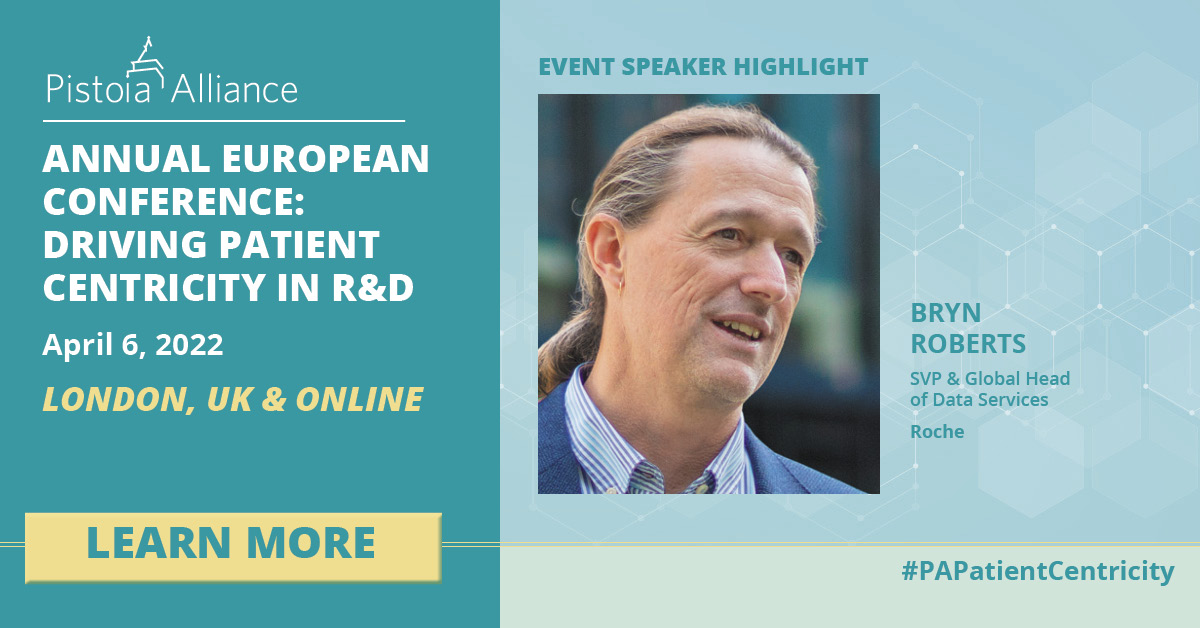
Patient centricity is one of the hottest topics in life sciences with sophisticated health care consumers demanding more data and tools. It can empower patients, increase profits, and ultimately lead to better outcomes for all. During the Pistoia Alliance annual European conference in London on April 6, life science visionary leader Bryn Roberts, Ph.D., Global Head of Data and Analytics at Roche Diagnostics in Basel, will moderate a fascinating panel discussion about this important trend. We sat down with Bryn to get a preview of his panel insight.

Q: What is your definition of patient centricity?
A: It’s about considering the patient in everything we do. Patients are waiting for new treatments and care innovations, so every minute counts for their health and wellbeing. At Roche, we talk about ‘doing now what patients need next’. A similar philosophy applies in all patient-centric organizations, which put patients at the center of innovation and focus on the highest unmet medical needs.
Q: Can you explain the concept of personalized health care (PHC) in more depth?
A: Often described as ‘the right treatment for the right patient at the right time’. PHC involves the tailoring of care for individuals, or groups of individuals, based on their specific characteristics, to optimize safety and clinical outcomes. In many cases, it also leads to savings in the healthcare system and broader society. The more we understand a patient and the mechanisms involved in their disease, the more we can target diagnostics to appropriate biomarkers and personalize treatments based on both genotypic and phenotypic factors.
Q: How do PHC and patient-centricity complement and contribute to medicines R&D?
A: In selecting drug targets in research, we prioritize based on a deep understanding of disease biology and the potential benefit for patients and their families. In clinical trials, for example, involving patients in the design of the studies can bring many benefits, including improving the quality of assessments, increasing participation and adherence, and reducing the burden of study participation.
Q: How do you tailor personalized health care to different generations of users, some younger consumers are more comfortable with technology than older patients.
A: That is all part of patient-centered design. We need to cater for diversity in study participants, such as confidence and competence in using digital solutions. In studies using smartphone-based digital biomarkers, we’ve done research on the design of our digital assessments and how to improve engagement, adherence, data quality, etc. There have been surprises along the way, such as the difference between how men and women tend to carry their smartphones during a normal day – in a pocket or in a bag. Some of our studies involve children, so we designed digital biomarkers based on age-appropriate games. One example of this was for young people with Spinal Muscular Atrophy, a rare genetic disease, with game tasks such as ring the bell, tap the monster, or squeeze the tomato.
Q: Tell us more about the growing interest in technologies such as wearables and sensors.
A: Notable successes are being seen in neurology where we can measure, with high sensitivity and objectivity, factors such as movement, cognition, and memory. Other examples include direct assessment of visual acuity in ophthalmology and electronic patient-reported outcomes in several disease areas. With these tools, we see a lot of potential medical value because they can enable more precise monitoring of disease symptoms, progressing, response to treatment, and potential treatment side-effects, longitudinally in the real-world setting. Remote monitoring and digital assessment, potentially combined with telemedicine, can also reduce the burden on patients if they don’t have to travel to the clinic as frequently. These tools can also be empowering for patients, providing them with valuable personalized insights, which enable them to benefit more from interactions with healthcare professionals and to adapt their lifestyle in areas like diet, exercise, and sleep – multiple sclerosis is a prime example.
Q: As an active member of the Pistoia Alliance, which promotes collaboration and innovation in life sciences, how do you and other member companies balance collaboration vs. competition?
A: Although companies compete to bring the most innovative and beneficial new diagnostics and medicines to patients, we collaborate in many ways for the greater good. Examples include data sharing to accelerate disease understanding and developing and validating new clinical assessments to facilitate clinical trials. These types of collaborations have clearly had positive impacts on our ability to address conditions such as Autism Spectrum Disorders and, of course, COVID-19. Given the long timelines and high attrition rates in the development of new medicines, competition is beneficial for patients, as more ‘shots on goal’ increases the probability of new treatments being launched sooner.
Q: How do you combine that need to serve the greater good, while also staying profitable?
A: We believe strongly that if a company is successful at bringing innovative solutions to the market that serve the greater good, namely improved care for patients and reduced societal burden, they will create a profitable business.
The Pistoia Alliance’s ‘Driving Patient Centricity in R&D’ conference takes place on April 6, 2022, at the Millennium Gloucester Hotel in London, and online. For further details visit: https://www.pistoiaalliance.org/eventdetails/spring-conference-2022/
